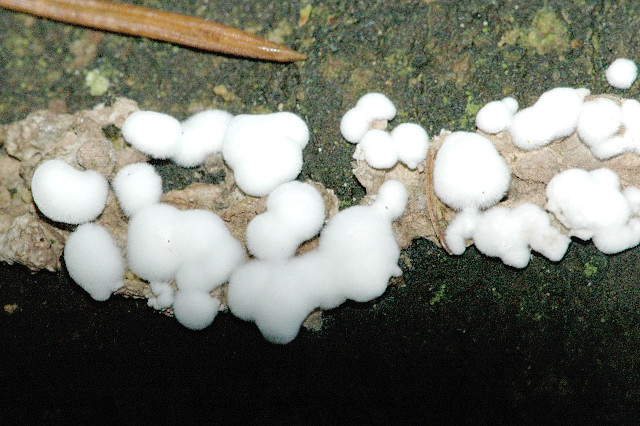- Myxomycota
Taxobox
name = Plasmodial Slime Molds

image_width = 220px
image_caption = "Diderma testaceum"
domain =Eukaryota
regnum =Amoebozoa
phylum =Myxomycota
subdivision_ranks = Classes
subdivision =Ceratiomyxomycetes Echinosteliomycetes Myxogasteromycetes Stemonitomycetes "Myxomycota" is a phylum of the Kingdom
Amoebozoa related toprotist s. The name comes from the Greek "Myxo", meaning "slime", and mycota, meaningfungus . They are also known as theplasmodial oracellular slime molds.Some would also consider "myxomycota" as a kingdom unto itself, with an unsettled phylogeny because of conflicting molecular and developmental data.
Life Cycle
When a "Myxomycota" spore germinates, it cracks, releasing an amoeba-like cell called a myxamoeba. The myxamoeba moves like an amoeba, and ingests food via
phagocytosis . Its food can includemicroorganism s and nonliving organic matter. The myxamoeba will divide as it eats. When two myxamoeba of different mating strains (of different populations) find each other, they will merge, forming azygote . The zygote itself will not divide, but rather it will grow as its nucleus divides, forming a large, multinucleate cell called a plasmodium. The plasmodium will continue to consume organic matter through phagocytosis. After some time, the plasmodium will travel to an open area and convert into a spore-bearing structure called asporangia . Spores will be released.Reproduction
"Myxomycota" can form
swarm cell s thataggregate , fuse, form asporangia ,sporulate , and return toamoeba l or swarm cell stages. The "Myxomycota" themselves arehaploid , and can switch betweenamoeboid andflagellated forms. Thegametes fuse into azygote , which then becomes aplasmodium , which can produce fruit-likespores .ee also
*
Acrasiomycota
*Dictyosteliomycota References
*www.cit.gu.edu.au/~sosic/reports/CIT-95-14.ps.Z
*C.J. Alexopolous, Charles W. Mims, M. Blackwell et al., "Introductory Mycology, 4th ed." (John Wiley and Sons, Hoboken NJ, 2004) ISBN 0-471-52229-5
*http://www.botany.hawaii.edu/faculty/wong/Bot201/Myxomycota/Myxomycota.htm
Wikimedia Foundation. 2010.
